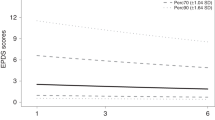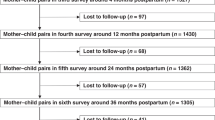Abstract
Objectives
Examine maternal and paternal ADHD and ASD symptoms in relation to very preterm (VPT) and full-term (FT) children’s ADHD and ASD symptoms.
Study design
In this longitudinal study, maternal- and teacher-report of child ADHD and ASD symptoms were obtained for 119 children (VPT = 79, FT = 40) at age 5-years using the Conner’s Rating Scale-Revised (CRS-R) and Social Responsiveness Scale-2 (SRS-2). A biological parent completed self- and observer-report CRS-R and SRS-2, and measures of mood/affect, stress, and social support to assess psychosocial distress. Data were analyzed using mixed-effect models adjusted for covariates.
Results
Child ADHD symptoms were associated with VPT birth, maternal distress, and maternal ADHD symptoms (p ≤ 0.02), and paternal ADHD symptoms (p < 0.001). Regarding ASD, VPT birth and parental ASD symptoms were associated with child ASD symptoms (p ≤ 0.009). Parental symptoms and birth group had no interaction.
Conclusions
VPT birth and parental psychopathology represent independent risks for ADHD and ASD.
This is a preview of subscription content, access via your institution
Access options
Subscribe to this journal
Receive 12 print issues and online access
$259.00 per year
only $21.58 per issue
Buy this article
- Purchase on Springer Link
- Instant access to full article PDF
Prices may be subject to local taxes which are calculated during checkout

Similar content being viewed by others
References
Bhutta AT, Cleves MA, Casey PH, Cradock MM, Anand KJS. Cognitive and behavioral outcomes of school-aged children who were born preterm: a meta-analysis. JAMA 2002;288:728–37.
Danielson ML, Bitsko RH, Ghandour RM, Holbrook JR, Kogan MD, Blumberg SJ. Prevalence of parent-reported ADHD diagnosis and associated treatment among US children and adolescents, 2016. J Clin Child Adolesc Psychol. 2018;47:199–212.
Johnson S, Hollis C, Kochhar P, Hennessy E, Wolke D, Marlow N. Psychiatric disorders in extremely preterm children: longitudinal finding at age 11 years in the EPICure study. J Am Acad Child Adolesc Psychiatry. 2010;49:453–63.e1.
Maenner MJ. Prevalence of Autism Spectrum Disorder Among Children Aged 8 Years — Autism and Developmental Disabilities Monitoring Network, 11 Sites, United States, 2016. MMWR Surveill Summ. 2020 [cited 2020 Aug 24];69. Available from: https://www.cdc.gov/mmwr/volumes/69/ss/ss6904a1.htm
Agrawal S, Rao SC, Bulsara MK, Patole SK. Prevalence of autism spectrum disorder in preterm infants: a meta-analysis. Pediatrics. 2018 Sep [cited 2019 Dec 29]. Available from: http://pediatrics.aappublications.org/content/142/3/e20180134
Rommelse NN, Franke B, Geurts HM, Hartman CA, Buitelaar JK. Shared heritability of attention-deficit/hyperactivity disorder and autism spectrum disorder. Eur Child Adolesc Psychiatry. 2010;19:281–95.
Salazar F, Baird G, Chandler S, Tseng E, O’sullivan T, Howlin P, et al. Co-occurring psychiatric disorders in preschool and elementary school-aged children with autism spectrum disorder. J Autism Dev Disord. 2015;45:2283–94.
Antshel KM, Russo N. Autism spectrum disorders and ADHD: overlapping phenomenology, diagnostic issues, and treatment considerations. Curr Psychiatry Rep. 2019;21:34.
Larsson H, Chang Z, D’Onofrio BM, Lichtenstein P. The heritability of clinically diagnosed attention deficit hyperactivity disorder across the lifespan. Psychol Med. 2014;44:2223–9.
Sandin S, Lichtenstein P, Kuja-Halkola R, Hultman C, Larsson H, Reichenberg A. The heritability of autism spectrum disorder. JAMA 2017;318:1182–4.
Lean RE, Lessov‐Shlaggar CN, Gerstein ED, Smyser TA, Paul RA, Smyser CD, et al. Maternal and family factors differentiate profiles of psychiatric impairments in very preterm children at age 5‐years. J Child Psychol Psychiatry. 2019 Aug [cited 2019 Sep 9]; Available from: https://onlinelibrary.wiley.com/doi/10.1111/jcpp.13116
Anttila V, Bulik-Sullivan B, Finucane HK, Walters RK, Bras J, Duncan L, et al. Analysis of shared heritability in common disorders of the brain. Science 2018;360:eaap8757.
Joelsson P, Chudal R, Uotila J, Suominen A, Sucksdorff D, Gyllenberg D, et al. Parental psychopathology and offspring attention-deficit/hyperactivity disorder in a nationwide sample. J Psychiatr Res. 2017;94:124–30.
Lauritsen MB, Pedersen CB, Mortensen PB. Effects of familial risk factors and place of birth on the risk of autism: a nationwide register‐based study. J Child Psychol Psychiatry. 2005;46:963–71.
Ronald A, Pennell CE, Whitehouse AJO. Prenatal maternal stress associated with ADHD and autistic traits in early childhood. Front Psychol. 2010;1:223.
Durkin MS, Maenner MJ, Baio J, Christensen D, Daniels J, Fitzgerald R, et al. Autism spectrum disorder among US children (2002–2010): socioeconomic, racial, and ethnic disparities. Am J Public Health 2017;107:1818–26.
Miller LL, Gustafsson HC, Tipsord J, Song M, Nousen E, Dieckmann N, et al. Is the association of ADHD with socio-economic disadvantage explained by child comorbid externalizing problems or parent ADHD? J Abnorm Child Psychol. 2017
Brumberg HL, Shah SI. Born early and born poor: An eco-bio-developmental model for poverty and preterm birth. J Neonatal-Perinat Med. 2015;8:179–87.
Rogers CE, Kidokoro H, Wallendorf M, Inder TE. Identifying mothers of very preterm infants at-risk for postpartum depression and anxiety before discharge. J Perinatol J Calif Perinat Assoc. 2013;33:171–6.
U.S. Census Bureau. U.S. Census Bureau QuickFacts: St. Louis city, Missouri. 2019 [cited 2021 Jan 29]. Available from: https://www.census.gov/quickfacts/stlouiscitymissouri
Conners CK, Sitarenios G, Parker JD, Epstein JN. The revised Conners' Parent Rating Scale (CPRS-R): factor structure, reliability, and criterion validity. Journal of abnormal child psychology. 1998;26:257–68.
Egger HL, Angold A. Common emotional and behavioral disorders in preschool children: presentation, nosology, and epidemiology. J Child Psychol Psychiatry. 2006;47:313–37.
Constantino JN, Davis SA, Todd RD, Schindler MK, Gross MM, Brophy SL, et al. Validation of a brief quantitative measure of autistic traits: comparison of the social responsiveness scale with the autism diagnostic interview-revised. J Autism Dev Disord. 2003;33:427–33.
Conners CK, Erhardt D, Sparrow EP. Conners’ adult ADHD rating scales (CAARS): Technical Manual. In 1999.
Constantino JN, Todd RD. Intergenerational transmission of subthreshold autistic traits in the general population. Biol Psychiatry. 2005;57:655–60.
Treyvaud K, Inder TE, Lee KJ, Northam EA, Doyle LW, Anderson PJ. Can the home environment promote resilience for children born very preterm in the context of social and medical risk? J Exp Child Psychol. 2012;112:326–37.
Beck AT, Steer RA, Brown GK. Beck depression inventory-II. San Antonio. 1996;78:490–8.
Speilberger CD, Gorsuch R, Lushene R, Vagg PR, Jacobs GA. Manual for the state-trait anxiety inventory. Palo Alto, CA: Consulting Psychologists. 1983.
Abidin RR. Parenting Stress Index (PSI). Pediatric Psychology Press Charlottesville, VA; 1990.
Sarason IG, Levine HM, Basham RB, Sarason BR. Assessing social support: The social support questionnaire. J Pers Soc Psychol. 1983;44:127.
Warschausky S. Wechsler preschool and primary scale of intelligence. In: Kreutzer JS, DeLuca J, Caplan B, editors. Encyclopedia of Clinical Neuropsychology. New York, NY: Springer; 2011 [cited 2021 Jul 7]. p. 2690–3. Available from: https://doi.org/10.1007/978-0-387-79948-3_1606
Rubin DB. Multiple Imputation after 18+ Years. J Am Stat Assoc. 1996;91:473–89.
Moreyra A, Dowtin LL, Ocampo M, Perez E, Borkovi TC, Wharton E, et al. Implementing a standardized screening protocol for parental depression, anxiety, and PTSD symptoms in the Neonatal Intensive Care Unit. Early Hum Dev. 2021;154:105279.
Grunberg VA, Geller PA, Hoffman C, Njoroge W, Ahmed A, Patterson CA. Parental mental health screening in the NICU: a psychosocial team initiative. J Perinatol J Calif Perinat Assoc. 2022;42:401–9.
Chronis-Tuscano A, O’Brien KA, Johnston C, Jones HA, Clarke TL, Raggi VL, et al. The relation between maternal ADHD symptoms & improvement in child behavior following brief behavioral parent training is mediated by change in negative parenting. J Abnorm Child Psychol. 2011;39:1047–57.
Faraone SV, Monuteaux MC, Biederman J, Cohan SL, Mick E. Does parental ADHD bias maternal reports of ADHD symptoms in children? J Consult Clin Psychol. 2003;71:168–75.
Fergusson DM, Lynskey MT, Horwood LJ. The effect of maternal depression on maternal ratings of child behavior. J Abnorm Child Psychol. 1993;21:245–69.
Cussen A, Sciberras E, Ukoumunne OC, Efron D. Relationship between symptoms of attention-deficit/hyperactivity disorder and family functioning: a community-based study. Eur J Pediatr. 2012;171:271–80.
Grizenko N, Shayan YR, Polotskaia A, Ter-Stepanian M, Joober R. Relation of maternal stress during pregnancy to symptom severity and response to treatment in children with ADHD. J Psychiatry Neurosci JPN. 2008;33:10–6.
Ask H, Gustavson K, Ystrom E, Havdahl KA, Tesli M, Askeland RB, et al. Association of gestational age at birth with symptoms of attention-deficit/hyperactivity disorder in children. JAMA Pediatr. 2018;172:749–56.
Lyall K, Constantino JN, Weisskopf MG, Roberts AL, Ascherio A, Santangelo SL. Parental social responsiveness and risk of autism spectrum disorder in offspring. JAMA Psychiatry. 2014;71:936–42.
Joseph RM, O’Shea TM, Allred EN, Heeren T, Hirtz D, Paneth N, et al. Prevalence and associated features of autism spectrum disorder in extremely low gestational age newborns at age 10 years. Autism Res. 2017;10:224–32.
Boomsma DI, Saviouk V, Hottenga JJ, Distel MA, de Moor MHM, Vink JM, et al. Genetic epidemiology of attention deficit hyperactivity disorder (ADHD index) in adults. PloS One. 2010;5:e10621.
Connolly S, Anney R, Gallagher L, Heron EA. Evidence of assortative mating in autism spectrum disorder. Biol Psychiatry. 2019;86:286–93.
Bernardo J, Friedman H, Minich N, Taylor HG, Wilson-Costello D, Hack M. Cognitive and motor function of neurologically impaired extremely low birth weight children. Paediatr Child Health. 2015;20:e33–7.
Funding
Study funding was provided by the National Institutes of Health (R01-HD057098, R01-MH113570, R01-MH113883, R01-DA046224, R34-DA050272, K02-NS089852, UL1-TR000448, K23-MH105179, K01-MH122735), Intellectual and Developmental Disabilities Research Center at Washington University (U54-HD087011), Office of Medical Student Research at Washington University (NIK T35 NHLBI Training Grant), Cerebral Palsy International Research Foundation, The Dana Foundation, March of Dimes, The Child Neurology Foundation, The Doris Duke Charitable Foundation, and A NARSAD Young Investigator Award from the Brain and Behavior Research Foundation. Study sponsors played no role in study design, data collection or analysis, writing of the report, or the decision to submit this paper for publication. We thank members of the Washington University Neonatal Developmental Research Group and the IDDRC at Washington University in St. Louis for study coordination and assistance with data collection. Thank you to the children and families involved with this study.
Author information
Authors and Affiliations
Contributions
HL Substantial contributions including: Formal analysis of data, writing and drafting initial manuscript, and review and editing of the manuscript. REL. Substantial contributions including: developing methodology of the study, supervision/oversight of the study, and data curation of the study, supervision of formal data analysis, and review and editing of the manuscript. TAS. Substantial contributions including: developing methodology of the study, data curation, and review and editing of the manuscript. CDS Substantial contributions including: conceptualization/design of study, developing methodology of the study, data curation, investigation, supervision/oversight of the study, funding acquisition, and review and editing of the manuscript. CER. Substantial contributions including: conceptualization/design of study, developing methodology of the study, data curation, investigation, supervision/oversight of the study, funding acquisition, supervision of formal analysis, and review and editing of the manuscript.
Corresponding author
Ethics declarations
Competing interests
The authors declare no competing interests.
Additional information
Publisher’s note Springer Nature remains neutral with regard to jurisdictional claims in published maps and institutional affiliations.
Supplementary information
Rights and permissions
About this article
Cite this article
Liljenwall, H., Lean, R.E., Smyser, T.A. et al. Parental ADHD and ASD symptoms and contributions of psychosocial risk to childhood ADHD and ASD symptoms in children born very preterm. J Perinatol 43, 458–464 (2023). https://doi.org/10.1038/s41372-022-01463-w
Received:
Revised:
Accepted:
Published:
Issue Date:
DOI: https://doi.org/10.1038/s41372-022-01463-w



